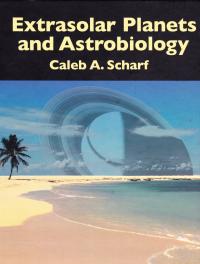Extrasolar Planets and Astrobiology
Extrasolar Planets and Astrobiology
By: Caleb A. Scharf
This book offers an advanced introduction to the increasingly robust fields of extrasolar planets and astrobiology.
For all sales outside of the United States, please contact Felicity Henson, fhenson@aip.org
Title information
This book offers an advanced introduction to the increasingly robust fields of extrasolar planets and astrobiology. No other text currently available applies this level of mathematics and physics, while also providing an extensive grounding in key issues of chemistry, biology, and geophysics. With extensive references to the literature and chapter-ending exercises, this book can be used as the core text for teaching undergraduate or introductory graduate level courses. The text will also provide astrobiologists with an indispensable “User’s Manual” when quick reference to key mathematical and physical techniques is needed. A continually updated online component, fully cross referenced with the text, is also available. Foreword by Geoff Marcy.
Chapter 1: Introduction, Background, and Preview
1.1 Introduction
1.2 Preview
Chapter 2: Star formation and proto-stellar collapse
2.1 Introduction
2.2 A brief cosmography
2.3 Observed proto-stellar structures
2.4 Proto-stellar collapse
2.5 Outside-in versus inside-out star formation
2.6 Triggering collapse
2.7 Angular Momentum in Collapse
2.8 Orbital Basics
2.9 Disk Evolution
2.10 Binary and multiple star systems
2.11 Brown dwarfs to planets
Chapter 3: Planet Formation
3.1 Introduction
3.2 Planet classes and formation scenarios
3.3 Coagulation of solids
3.4 Stages of growth
3.5 The rate of formation as a function of position
3.6 Planetesimal and Proto-planet migration
3.7 Final stages of planet formation
3.8 Planet formation summary
Chapter 4: Exoplanets
4.1 Introduction
4.2 Indirect Planet Detection
4.3 Direct Planet Detection and Imaging
Chapter 5: Life: a brief history, and its boundaries
5.1 Introduction
5.2 Two histories
5.3 What is terrestrial life?
5.4 The history of life on Earth
5.5 Boundary conditions and habitability
5.6 Deep Life
Chapter 6: Planetary radiation, comparative planetology, biosignatures, and Daisyworld
6.1 Introduction
6.2 The reflectivity of a planet: albedo
6.3 The thermal characteristics of a planet
6.4 Interpreting reflected light from planets
6.5 Total observed flux6 Comparative Planetology
6.7 The impact of life: biosignatures
6.8 Daisyworld
6.9 Introducing the daisies
6.10 Variations
6.11 Concluding thoughts
Chapter 7: Cosmochemistry, dust, and prebiotic molecules
7.1 Introduction
7.2 Elements and materials
7.3 The origin of dust
7.4 The Circumstellar Medium
7.5 Nucleation
7.6 Dust or molecule?
7.7 Formation of complex molecules
Chapter 8: Comets, meteorites, and proto-planetary disk structure
8.1 Introduction
8.2 Comets
8.3 Meteorites
8.4 Late time impactors and early Earth chemistry
8.5 Chemistry of the proto-planetary disk
Chapter 9: Habitable Zones
9.1 Introduction
9.2 The classical circumstellar habitable zone (CHZ)
9.3 Habitability through time
9.4 Additional factors
9.5 The Galactic Habitable Zone
Chapter 10: Alternate Habitable Zones and Beyond
10.1 Introduction
10.2 Earth: but not as we know it
10.3 Moons
10.4 Elemental constraints on life
10.5 Speculations on the origins of life
10.6 Concluding commentary and cautions
|
“The arrival of [this book] makes available to our community what should be the gold standard text…I suspect this text will become a much-loved, dog-eared friend to every amateur, student, or professional astrobiologist.” “Scharf’s coverage of exoplanets is quite wonderful and will be very valuable for classes.” “Caleb Scharf provides here a solid and mathematically-rich overview of astrobiology from a planetary perspective…suitable for both newcomers to the field and experienced researchers looking for a course textbook to recommend.” “The book is truly excellent. Scharf provides the quantitative background needed to understand topics such as albedo and the greenhouse effect…this is probably the best volume available for the physical sciences side of astrobiology. Summing up: Essential.” “I like this book very much. The writing style is clear and engaging and it provides more physics than most texts on astrobiology.” “If you’re getting serious about the study of astrobiology, you’ll want to know about this title.” |

